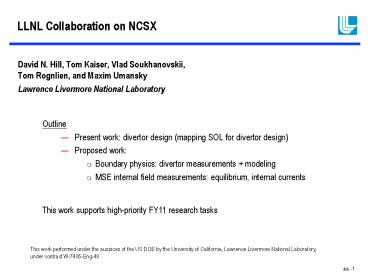LLNL Collaboration on NCSX - PowerPoint PPT Presentation
Title:
LLNL Collaboration on NCSX
Description:
LLNL Collaboration on NCSX. David N. Hill, Tom Kaiser, Vlad Soukhanovskii, ... Inversions possible with model of LCFS (similar to what we do now on DIII-D with ... – PowerPoint PPT presentation
Number of Views:25
Avg rating:3.0/5.0
Title: LLNL Collaboration on NCSX
1
LLNL Collaboration on NCSX
- David N. Hill, Tom Kaiser, Vlad Soukhanovskii,
Tom Rognlien, and Maxim Umansky - Lawrence Livermore National Laboratory
- Outline
- Present work divertor design (mapping SOL for
divertor design) - Proposed work
- Boundary physics divertor measurements
modeling - MSE internal field measurements equilibrium,
internal currents
This work supports high-priority FY11 research
tasks
This work performed under the auspices of the US
DOE by the University of California, Lawrence
Livermore National Laboratory, under contract
W-7405-Eng-48
2
LLNL began looking at boundary physics for NCSX
in 2000
- Internal funding for three years
- Engaged Greifswald W7-X boundary group to assist
with development of 3D SOL model - Worked with W7-AS group to apply
VMEC/MFBE/GOURDON codes to map structure of the
proposed NCSX coil set - Began looking at potential diagnostics for SOL
measurements. - Very modest OFES funding since 2002
- Focus on mapping structure of SOL plasma as
equilibrium has evolved - Focus on mapping SOL to divertor structures to
support design activies - Reduced the scope of our collaboration with
Greifswald to periodic consulting on their 3D
SOL code
3
Field line tracing using MHD equilibrium from
either PIES or VMEC/MFBE determines SOL and
divertor geometry
- Extensive benchmarking activity during FY05-06 to
compare SOL geometry as determined by PIES and
VMEC/MFBE equilibrium codes. Some differences are
observed, but within uncertainties. - Computed SOL geometry used in deriving conceptual
design for divertor plates. SOL transport
simulated by magnetic field line diffusion.
4
LLNL is supporting design of PFCs
- Heat flux is estimated by mapping LCFS field
lines to divertor targets. - Field lines are a bit short (higher Te at
target), but density is higher (lower Te at
target). Different than Local Island Divertors. - Do we need the inner target plates during early
low-power operation?
5
Infrared and visible TV cameras can provide
information on 3D SOL structure provided
appropriate viewing geometry.
- Wide-angle tangential views provide outline at
single cross section. - Inversions possible with model of LCFS (similar
to what we do now on DIII-D with recycling and
ELMs). - Also possible to generate simulated diagnostic
images. - Imaging through most ports will require
re-entrant optics to obtain desired field of
view, so most of the cost is related to
engineering design activities.
6
Livermore Is Responsible for Divertor IR Imaging
on DIII-D and Has Used the Data to Validate 2D
SOL models
- IR brightness converted to surface temperature,
from which heat flux can be derived. - Heat flux profiles mapped to MHD equilibrium.
- Measurements can be compared with simulations.
Example shows UEDGE 2D simulation. - On DIII-D, divertor Thomson (LLNL-GA
collaboration) provides 2D temperature and
density to compare with simulation.
2d reconstruction of plasma pressure profile in
detached divertor plasma in DIII-D.
7
LLNL Brings Experience Designing, Building, and
Using World-Class DIII-D MSE System to NCSX
Internal Current Profile Measurements.
- MSE routinely used to constrain MHD
reconstruction of DIII-D plasmas with strong
current profile modification (Advanced Tokamak,
Hybrid, Negative Central Shear, Current Holes,
edge bootstrap currents). DIII-D will not run AT
experiments without MSE. - Calibration for precision polarization
measurements, proper line-of-sight, adequate
spatial resolution, are key elements to
successful MHD reconstruction. - Existing collaborations with U. Wisconsin and
General Atomics complement strengths of the
Livermore team.
8
BES measurements verify strong RSAE localization
around qmin location
BES measurements verify strong RSAE localization
around qmin location
119346
A
B
MSE q-profile
A
Major Radius (m)
119345
B
- BES makes radially localized measurements of
density fluctuations - Combined with MSE, BES data confirm high-n RSAE
density fluctuations are localized near qmin.
Mike Van Zeeland General Atomics
9
Some general comments on collaborations
- Collaborations can bring many benefits to host
institution - Unique skills/experience in personnel, new
hardware capability - Potentially cheaper and/or more flexible
workforce - Free energy and fresh ideas from an external
without the project perspective - Collaborations can bring many benefits to the
collaborating institution - New funding for people and equipment (as opposed
to more work for same people) - Opportunity to expand scope of research, applying
expertise to new problems - Increased recognition and invitation to branch
out further, tackle bigger challenges. - Some key elements of successful long-term
collaborations in experimental science - Fund people instrumentation design support
(free energy, safety valve, tangible assets) - Have clearly defined institutional roles for
collaborating institutions (more than
individuals) - Provide professional growth opportunities for
collaborators and help advertise role of host
institutions































